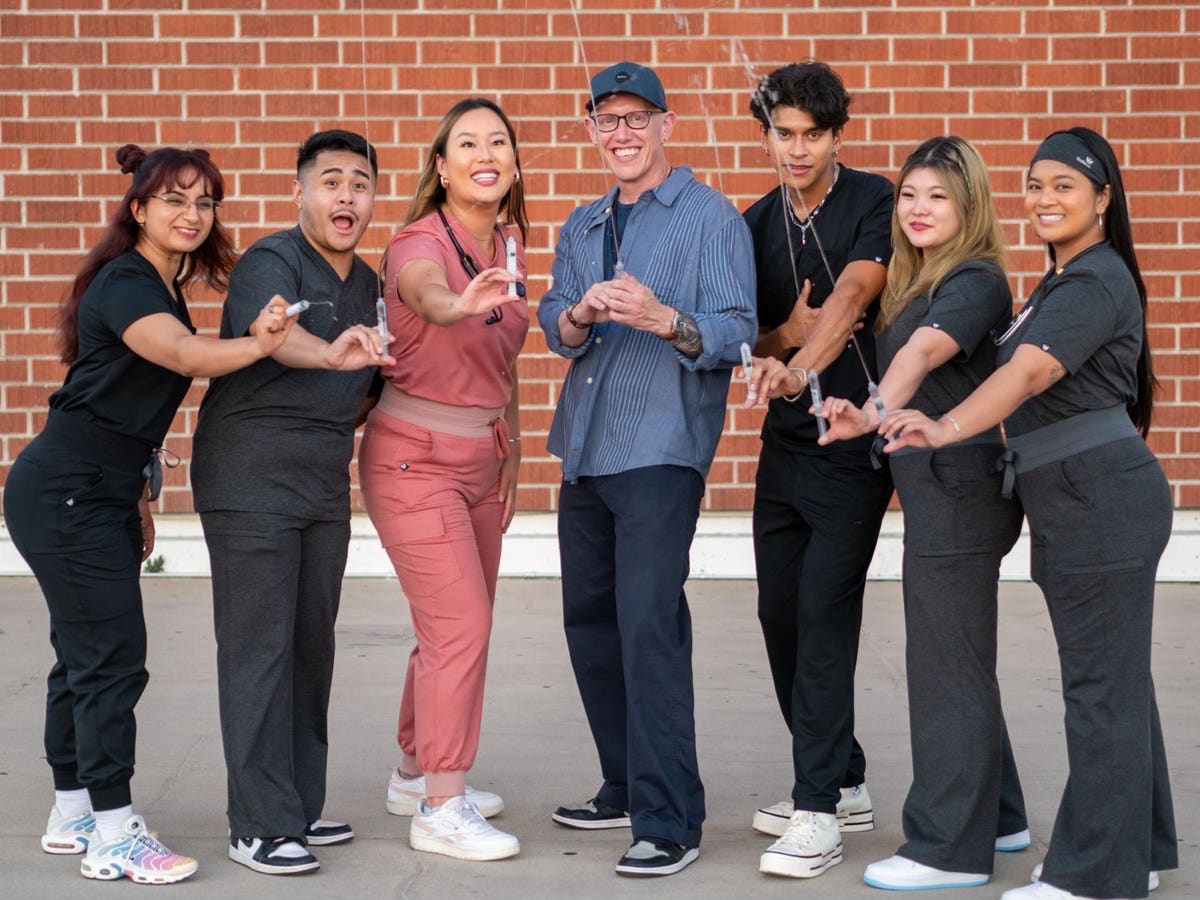
CEO, Dr. Anthony Guynes, and team wearing Soleya Scrubs
Soleya Scrubs
Dr. Anthony Guynes, an emergency medicine physician based in Seattle and CEO of Soleya Scrubs, has worked in over ten emergency departments. While the settings varied, he noticed one clear consistency: no one seemed excited about their scrubs, though everyone was wearing them. Despite the a crowded market with dozens of scrubs brands nationwide, he saw an unmet need. “All these brands were making scrubs out of bedsheets,” he recalls. “I wondered what could be done differently.”
At this earliest point, Guynes didn’t know the formal concept of TAM, Total Addressable Market, the total potential revenue a business could generate if it captured 100% of the available market. He did understand, however, that scrubs were a multibillion dollar market and that 9% of the workforce is in healthcare. “Seventeen percent of those individuals buy their own scrubs,” he told me. Guynes found both “a market and a problem.”
He launched Soleya Scrubs in April 2024 and the company has since shipped approximately 2,000 orders with a 40% repeat purchase rate. In one year, they have generated $250,000 in annual revenue, with projections to reach $1 million next year.
During our conversation we unpacked the history of how he turned a simple observation into a six-figure business — and what other healthcare professionals could learn from his approach.
Selecting a Co-Founder Team
When reconsidering his early days, Guynes told me he chose a partner, another physician, who shared his vision of elevating scrubs. After teaming up, they formed the first iteration of the company, Dolphin Scrubs. “I wanted a name that everyone loves.” And though the name carried some sentiment, the pairing between the two friends was more convenient than strategic. As the business grew, Guynes found himself handling most of the mechanics—developing ideas, contacting suppliers, and making connections. The duo made the cordial decision to separate, with Guynes continuing on as CEO.
A co-founder split is not uncommon and probably a path every start-ups need to anticipate as a plausible outcome. The often cited statistic from Noam Wasserman in his book “The Founder’s Dilemmas” states that 65% of startups fail due to co-founder or team conflict or mis-alignment. Though a natural evolution between leadership is a challenge, Guynes states its’s better to recognize this tension early. “Don’t be afraid to pivot the leadership, if you recognize that it’s not working out.” At that early stage they had each invested $20,000. He was happy to “figure it out before being a multimillionaire company.”
Photo of Dr. Anthony Guynes in his warehouse
Beth Guynes
Luckily, and perhaps less common, Guynes still considers his first co-founder a friend and stays in communication. He believes the decision was best for each individual and the company, “though it still felt like a loss,” he adds.
Guynes pushed forward and wanted another co-founder as he feels its “harder to stay motivated alone.” Around this time his wife, Beth Guynes, a nurse with familiarity in fabric and weaving, was reentering workforce after 10 years away. After ordering multiple brands of scrubs and returning all of them she noticed “scrubs hadn’t improved in 10 years.”
She was familiar with athleisure clothing and asked, “Why can’t I wear those to work?” Serendipitously, as Anthony’s first cofounder was exiting, Beth saw the vision, bought out the first cofounder, and transitioned onto the team.
They saw a billion-dollar company making athleisure and thought, “Is there any reason we can’t take this fabric and turn it into scrubs?” Anthony shared.
Building a Product
Anthony went to a technical fabric trade show with a sample of the athleisure shorts in hand. He asked experts, “Where can I get this exact fabric made?”
“The fabric itself wasn’t proprietary”, says Anthony. Under common law, he could use the same fabric used by an athleisure brand for his scrub company because it wasn’t owned by a single entity.
After finding a manufacturer, Anthony and Beth spent time upfront navigating production, distribution, branding, and marketing. Along the way they picked up a few key lessons..
“We focused too early on brand. It would have been better to focus on the initial prototype of product.” To Anthony, brand means nothing until you bring value to the customer. He advises focusing on the idea of the company, then prototype the product, and then with product in hand you can consider the brand.
Photo of Beth Guynes
Anthony Guynes
He also shared that he tapped into his network very early. He thought through the people he knew and found individuals willing to help build or consult. “Beth’s sister’s college roommate did our initial designs,” said Anthony.
After developing the initial prototype, he worked with friends and coworkers to get feedback. “We iterated from there.” he adds.
Mission and Future of Soleya
“Healthcare workers spend their lives dedicated to the wellness of others,” Beth shares. “It’s so easy to forget about caring for ourselves. But comfort is not a luxury.” But she reminds her customer base that “comfort is not a luxury.” Beth and Anthony hope to create a version of healthcare where self-care is just as important as patient care.
Three Business Lessons for Founders
Your frustration is data.
Every improvement starts with noticing what isn’t working in your daily world. Physicians already do this instinctively, channel that awareness into innovation.
Choose your cofounder carefully.
Shared enthusiasm and friendship isn’t enough. Align on work ethic, goals, and contribution early. If the team isn’t working remember, it’s easier to pivot leadership when the company is only worth $20,000 than at $2 million.
TAM matters, but not at first.
Understanding your total addressable market shows promise of the product and helps you scale, but the first step is proving you can make one product people love. Then you can measure how big it might grow.

